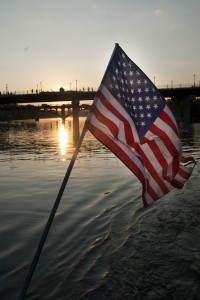All over America, people are gearing up to celebrate the July 4th holiday with family, fireworks, cookouts and, quite often, booze. 
Generally, there is nothing wrong with adults imbibing in a few brews at a gathering. But there is nothing patriotic about getting behind the wheel after doing so.
Consistently, the Fourth of July has been labeled the most dangerous holiday of the year in terms of crashes.This has to do with the fact that most people are off work, usually for several days at a time, it’s summer time and people are more apt to not only drink but feel obligated to travel to more than one destination.
We know that drinking and driving is attributed to about 30 percent of all fatal car accidents throughout the year. On July 4th, the rate of alcohol-related fatalities shoots up to nearly 40 percent. That doesn’t even include the drivers who may have been drinking, but whose blood-alcohol concentrations measured less than 0.08 percent. (It’s worth noting a person can still be deemed intoxicated, even if his or her BAC is not above that standard 0.08 percent threshold.)
In 2013, there were 512 people killed in motor vehicle collisions over the Fourth of July holiday, which ran from 6 p.m. July 3rd through 6 a.m. July 8th. Of those who died, 200 were killed in crashes where at least one motorist had a blood-alcohol level that exceeded 0.08 grams per deciliter or higher. Further, more than one-fifth of those drivers had a blood-alcohol level that exceeded 0.15 or higher, which is almost twice the legal limit.
The rate of impairment, according to the National Highway Traffic Safety Administration, was five times higher at night than during the day.
Young drivers are especially vulnerable during this time. During the Fourth of July holiday period for 2013, almost half of drivers between the ages of 18 and 34 who were killed in car accidents were drunk.
Between 2009 and 2013, there were 750 people killed just during the Fourth of July holiday. This is not a new concern, but it’s a serious and ongoing one.
Because of the wide scope of the problem, local law enforcement agencies across the country are adhering to a “Drive Sober or Get Pulled Over” campaign that involves increased patrols, DUI checkpoints and zero tolerance for impaired drivers.
Last year, police in Boston carried out a “no refusal” blood draw DUI checkpoint. While the U.S. Supreme Court has ruled that blood draws can’t be done absent driver consent without a warrant, police agencies in these operations partner with local judges/magistrates to have them on site to issue warrants on the spot for drivers who refuse.
Considering a first-time DUI on average costs an offender about $10,000 – and that’s assuming he or she wasn’t involved in an accident and didn’t hurt anyone – it’s simply not worth it. This point is even further underscored when we consider the unfathomable and tragic loss of human life that can result when people get behind the wheel drunk. It simply doesn’t need to happen.
There are a number of alternatives to driving drunk. The first is to make plans to stay where you are once you start drinking. The second is to assign a sober driver to get everyone home safely or make sure you’re within walking distance. Finally, there are a number of inexpensive or even free ride services, from taxis to apps like Uber and Lyft to the “Sober Ride” program offered by AAA. In Boston, “BeMyDD” gives would-be impaired drivers a safe ride home in their own vehicle for a pickup fee of $25 plus mileage.
If you or someone you love has been injured a Boston drunk driving accident, call for a free and confidential appointment at (617) 777-7777.
Additional Resources:
4th of July Drunk Driving Prevention Campaign “Drive Sober Get Pulled Over” Enforcement Materials, June 2015, National Highway Traffic Safety Administration
More Blog Entries: Report:
Massachusetts is Mid-Level on Drunk Driving Prevention, June 19, 2015, Boston Drunk Driving Injury Lawyer Blog
 Boston Drunk Driving Accident Lawyer Blog
Boston Drunk Driving Accident Lawyer Blog

